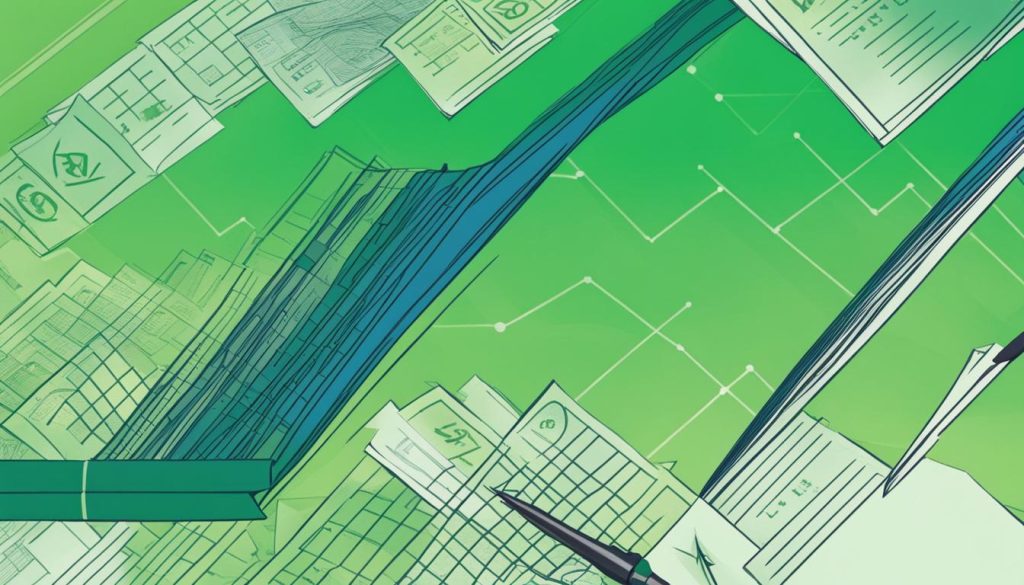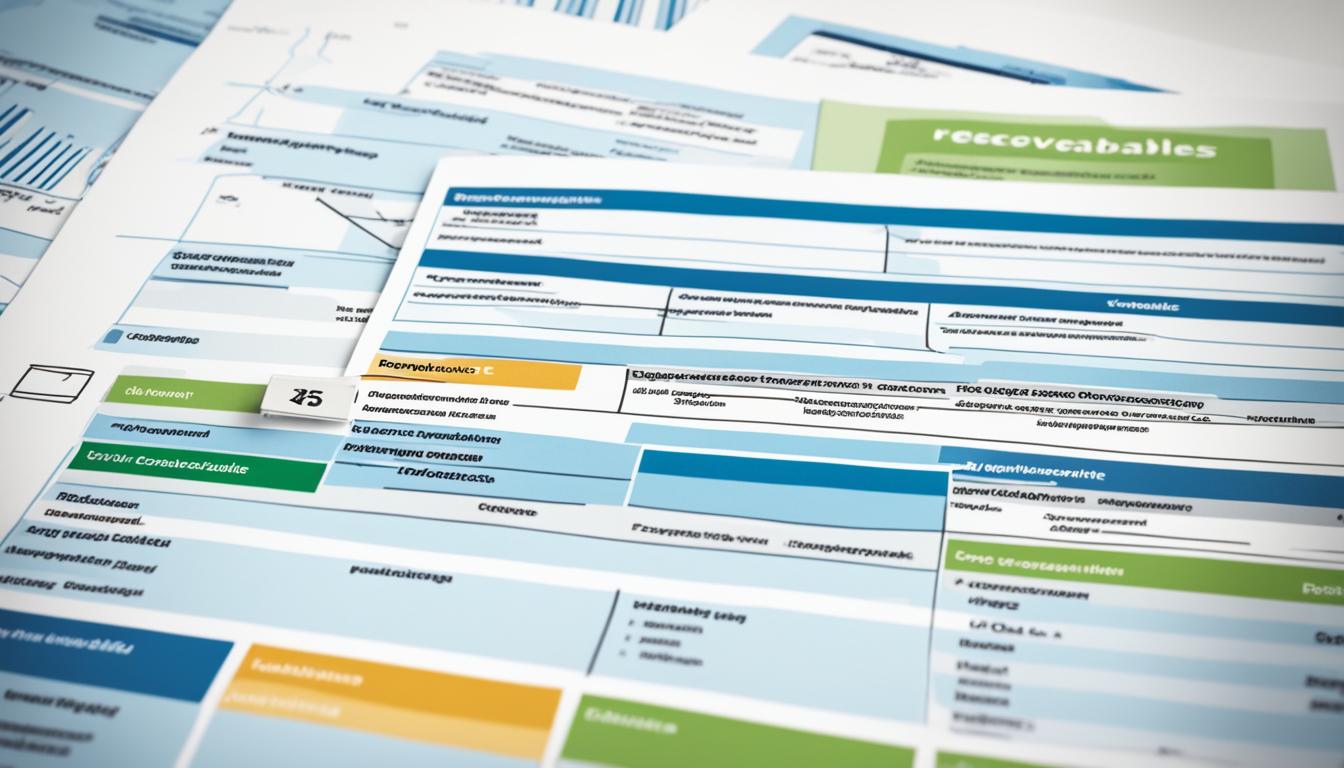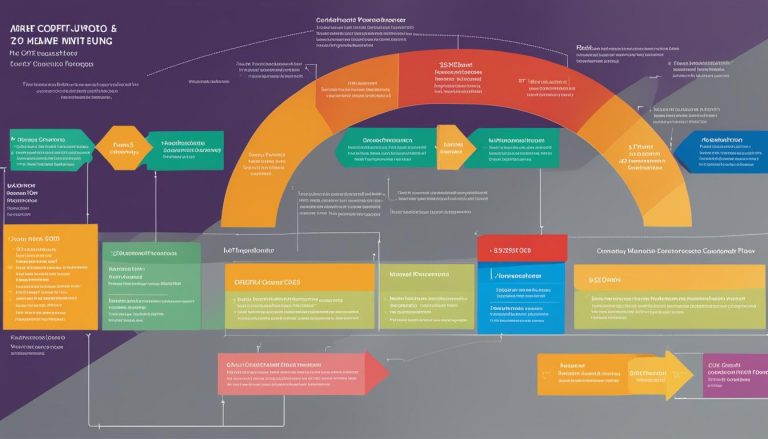Ever asked yourself, “How can I make customers pay on time?” You’ve sent letters, emails, called them, and maybe even threatened to take them to court. But usually, they don’t pay because they’re unhappy with what they got, they choose when to pay, they’re temporarily out of money, or they’re going bankrupt.
To better your cash flow and handle your receivables, here’s what you can do: make customer service important when you’re trying to collect money, use financial management software to keep ahead, and be ready for excuses from those who pay late.
Key Takeaways:
- Prioritize customer service to improve collections and cash flow.
- Stay ahead of the game with financial management software.
- Anticipate and address late-payer responses effectively.
- Properly managing accounts receivable is crucial for a healthy cash flow.
- Recording and monitoring accounts receivable helps optimize cash flow.
Customer Service-Driven Collections
Collections should not just send invoices and reminders. They should make calls to customers before the due date. This lets you check if they’re happy with your service and fix any issues. If they’re happy, ask for payment in a nice but serious way. If there are problems with paying, remind them of your payment rules. Clear expectations and good communication can improve collections and cash flow.
Enhancing Customer Service in Collections
Putting customer service first in managing accounts receivable is key. Using customer service strategies in collections builds strong client relationships. It also makes their experience better.
“Providing excellent customer service in collections can significantly improve your chances of prompt payment.”
Don’t just send automated reminders. Try a personal touch instead. Call customers before they need to pay. Use it to check if they’re happy and to solve any problems. This also helps strengthen your relationship and shows the value you offer.
If the customer is happy, ask for payment right away. Say the amount and when it’s due clearly but kindly. Being proactive about collecting payments shows it’s important and creates urgency.
If there’s a delay or problem with payment, remind them gently of the agreement. Politely talk about the payment terms and stress on timely payment. Clear expectations and open talks can solve payment issues fast. This keeps cash flowing smoothly.
| Benefits of Customer Service-Driven Collections: |
|---|
| 1. Improved customer relationships and satisfaction. |
| 2. Higher likelihood of prompt payment. |
| 3. Enhanced credibility and professionalism. |
| 4. Reduced risk of payment disputes and conflicts. |
Customer service-driven collections practices improve your business. They get you paid faster and build good client relationships. Good customer service during collection benefits your cash and reputation.
Staying Ahead of the Game with Financial Management Software
To stay on top of your finances, the right financial management software is key. It helps you see clearly into your accounts receivable. This way, you make smart choices and boost your cash flow.
Financial software lets you look at your accounts receivable aging report. This report shows your unpaid invoices, helping you see which need quick action. By focusing on the largest balances, you get the most benefit from your collection efforts.
Another perk of this software is planning with your financial forecast. You can see potential money tight spots before they happen. This lets you keep enough funds on hand, steering clear of panic-driven choices. It keeps your cash flow steady.
Good cash management is all about overseeing cash flow and receivables well. The best financial management software keeps you informed and prepared. You can focus on what needs attention and plan for future needs. These tools help keep your business financially healthy.
Financial Management Software Comparison
| Software | Features | Price |
|---|---|---|
| Software A | Accounts receivable tracking, financial forecasting, customizable reporting | $99/month |
| Software B | Automated invoicing, real-time cash flow monitoring, integration with accounting systems | $149/month |
| Software C | Customer portal, payment reminders, analytics dashboard | $79/month |
Anticipating Responses from Late Payers
When you have customers who pay late, it’s crucial to predict and handle their reactions well. Knowing and dealing with their worries can help you get payments on time. This keeps your cash flow strong.
To keep cash flowing, you need to act fast to solve delayed payments. You should also set up a payment plan that suits both sides. Here are some tips to think about:
1. Verify Payment Claims
If a customer says they’ve sent the check, don’t just wait. Kindly ask for details like when they sent it and the check number. This lets you keep track of the payment. You ensure it’s dealt with quickly.
2. Partial Payments and Remaining Balances
Don’t forget the rest of the money when a customer makes a partial payment. Ask when they can pay the full amount. Or, suggest making a plan to pay bit by bit. This keeps things clear and helps both sides.
3. Exploring Cash Flow Solutions
If your customer has money problems, show understanding but also protect your business. Talk about possible solutions like delayed checks or paying slowly over time. This shows you’re willing to find a solution together.
4. Addressing Dissatisfaction
When a late payment is due to a customer not being happy, address their issues. Work together to solve the problem in a way that pleases both of you. By responding to their concerns, you avoid future payment problems and keep a good relationship.
By predicting and dealing with late payers’ reactions, you can handle payment delays well. You can make a payment schedule that suits everyone. This makes managing your cash flow easier.
The Impact of Managing Receivables on Cash Flow
Proper handling of what customers owe is key for good cash flow. Money owed to your business for goods or services is known as accounts receivable. Not getting paid on time can hurt your cash flow. It’s listed as an asset on the balance sheet and impacts capital.
To improve how you collect, ensure payments are on time. Also, keep an eye on how quickly payments turn over. Using financial models helps predict cash flow. Doing this makes sure your business has a steady flow of money.
Benefits of Managing Receivables
Managing what’s owed to you brings several benefits:
- Improved Cash Flow: You get paid faster, which means more cash on hand for expenses and growth.
- Enhanced Financial Predictability: Keeping track of payments and using models helps you see future cash flow. This makes planning easier.
- Reduced Bad Debt: Catching payment issues early prevents them from becoming bigger problems.
- Stronger Customer Relationships: Talking openly with customers builds trust. This encourages them to pay on time.
“Properly managing receivables keeps cash flow healthy. By ensuring payments are on time, monitoring turnover, and using models, businesses stay financially stable.”
Financial Modeling for Managing Receivables
Financial modeling gives a detailed look at your business’s finances. It shows what cash flow might look like in the future. For receivables, it helps in making smarter decisions.
Including receivable data in your models helps you:
- Estimate Cash Flow: See when and how much money will come in, which helps with managing cash better.
- Find the Best Credit Terms: Analyze how different payment terms affect cash flow. This lets you choose the best terms for both you and your customers.
- Understand Capital Needs: Models show how much money you need to keep operations going and to grow.

Leveraging models for receivables gives you a solid way to make choices, spot improvements, and better manage cash.
| Key Benefit | Impact on Cash Flow |
|---|---|
| Timely Payment | Helps avoid delays in getting paid |
| Accounts Receivable Turnover | Makes collecting payments faster |
| Financial Modeling | Improves predicting cash flow and assists in making decisions |
By using these methods and models, businesses can control their receivables well. This boosts cash flow and supports financial growth.
Recording and Monitoring Accounts Receivable
Managing your accounts receivable is key. It means keeping accurate records and watching the balance closely. Accounts receivable is the money your customers owe you for your products or services. By keeping track of this, you can better understand your cash flow and overall financial health.
This type of asset appears on your balance sheet as a current asset. It shows the funds you expect to collect within a year. As customers settle their bills, your business’s cash flow gets a boost, and the accounts receivable balance goes down.
Keeping an eye on your accounts receivable balance over time is a smart move. It helps you see how well you are turning receivables into cash. A rise in accounts receivable could mean you’re making more credit sales. A drop might show you’re doing well in collecting debts.
“Accurate recording and monitoring of accounts receivable provides valuable insights into your cash flow and financial statements.”
Understanding your accounts receivable balance is critical for your cash flow and financial reports. By monitoring this balance closely, you can spot trends. Based on these trends, you can take steps to improve how you collect debts. This helps you make smart decisions about your cash flow and earnings.
Good management and oversight of accounts receivable are crucial. They help you use your resources well and maintain strong finances. By focusing on your accounts receivable balance, you can enhance your cash flow. This, in turn, helps you make better choices to grow your business.
| Benefits of Recording and Monitoring Accounts Receivable | Actions |
|---|---|
| Gain visibility into your cash flow | Regularly update and reconcile your accounts receivable records |
| Identify outstanding invoices and prioritize collections efforts | Analyze your accounts receivable aging report |
| Evaluate the impact of accounts receivable on net earnings | Assess cash-to-receivable ratios |
By using these strategies, you can make the most of your accounts receivable management. This leads to better cash flow for your business.
Days Sales Outstanding (DSO)
It’s critical to manage receivables for good cash flow. Days Sales Outstanding (DSO) is a key metric for this. It shows the average days it takes for customers to pay invoices.
Knowing your DSO can reveal a lot about your sales, payment speeds, and how well you collect payments. A lower DSO means quicker payments from customers, boosting your cash flow.
A DSO under 45 days is seen as good. But, what’s best can vary based on your industry and cash flow needs.
If your DSO is high or getting higher, it could mean customers are paying late. This may require more effort to collect or changing payment terms. Watching your DSO helps you spot issues early and improve your cash handling.
| DSO | Interpretation |
|---|---|
| Less than 45 days | Generally considered good |
| 45 – 60 days | Payment delays may be occurring |
| Above 60 days | Collections efforts may be needed |
Understanding your DSO and working to improve it is key. It ensures your business has the cash flow needed to thrive.
The Impact of Accounts Receivable on Financial Modeling
Accounts receivable is key in financial models, showing how much cash will come in the future. It helps forecast cash flows when customers pay up. Metrics like Days Sales Outstanding (DSO) give an idea of when to expect payments. Although seen as a positive in financial statements, unpaid receivables can turn into losses. By analyzing these balances, companies make smarter decisions for their finances.
To display how crucial accounts receivable are, see this table:
| Year | Accounts Receivable Balance | Revenue | Cash Flow |
|---|---|---|---|
| 2018 | $100,000 | $1,000,000 | $900,000 |
| 2019 | $120,000 | $1,200,000 | $1,000,000 |
| 2020 | $130,000 | $1,500,000 | $1,100,000 |
In the above table, as the receivables go up, revenue does too. Yet, cash flow doesn’t always follow. Growing receivables can mean later payments and possible losses if not collected. This shows why managing them well is crucial for turning more revenue into cash flow.
Financial models use receivables to project cash coming in. They look at past data to forecast future cash flow. This helps make smart choices on managing cash, investing right, and staying healthy financially.
To make financial modeling better, businesses should focus on:
- Efficient receivables management: Put in place strategies for quick payment collection and lowering receivables.
- Cash flow forecasting: Use past data on receivables to predict future cash and plan accordingly.
- Monitoring DSO: Watch Days Sales Outstanding to spot trends and tackle any problems early.
- Credit policies: Create fair credit policies to keep overdue payments and bad debts low.
By applying these strategies, companies can improve their cash flow forecasts. This leads to smart decision-making for growth and financial stability.
Image:
Optimizing Accounts Receivable for Improved Cash Flow
To boost cash flow, streamline your accounts receivable. Make sure invoices go out right away and are right every time. This prevents any hold-ups with your cash coming in. Also, set out your payment rules clearly from the start and tell your customers about them. This includes any deals for paying early or fees for being late.
Always get in touch with your customers fast if they miss a payment. This way, you can talk it over and figure it out together. Offering rewards for early payments and fees for late ones also helps. These steps make sure you get paid on time, which can enhance your cash flow.
Getting your invoices out quickly and correctly is key. This sets the stage for when you expect to be paid. Not dragging your feet with invoices keeps the money flowing smoothly.
It’s also smart to be upfront about your payment terms. Tell your customers when payments are due and about any discounts or penalties. This keeps everyone on the same page and can cut down on late payments.
If a payment doesn’t come through, reach out without delay. Keeping the lines of communication open can solve issues faster. This approach can lead to quicker payments.
Think about giving discounts to people who pay early. Or, charge extra for payments that come in late. These tactics can inspire your customers to pay up sooner rather than later. They help keep your cash flow steady.
Keeping your accounts receivable fine-tuned is an ongoing task. You should always be checking and tweaking things. Keep an eye on how long it takes to collect payments. Also, look out for any patterns in late payments. Knowing this can help you make smart changes.
In the end, getting your accounts receivable right is crucial for your cash flow. Make sure your invoicing is spot on, your payment terms are clear, and you’re quick to follow up. These steps will help keep your cash flow healthy.
Conclusion
Effective management of accounts receivable is key to ensuring a strong cash flow and a secure financial future. By focusing on customer service in collections and using the latest financial management tools, you can get better at managing your cash flow.
Making sure to record and watch your accounts receivable closely helps. Knowing your Days Sales Outstanding (DSO) is also important. These steps guide your business decisions and help your cash flow.
To improve your cash flow, send out invoices quickly and make sure they’re right. Have clear payment rules from the start and always contact customers if they miss payments. By doing these things, you can boost your cash flow and strengthen your business’s finances.
FAQ
How can I improve my collections and manage my receivables effectively?
Why is customer service important in collections?
How can financial management software help me stay on top of my cash flow?
What should I do when dealing with late-paying customers?
How does managing receivables impact cash flow?
How do I accurately track and monitor accounts receivable?
What is Days Sales Outstanding (DSO) and how does it affect cash flow?
How does accounts receivable impact financial modeling?
How can I optimize my accounts receivable for improved cash flow?
What are the key takeaways for managing receivables and improving cash flow?
Source Links
- https://www.forbes.com/sites/rohitarora/2022/01/31/five-tried-and-true-ways-to-collect-receivables-faster-and-improve-cashflow/
- https://www.insperity.com/blog/how-to-improve-your-cash-flow-with-better-bill-collection/
- https://wealthfactory.com/articles/managing-accounts-receivable-for-increased-cash-flow/







